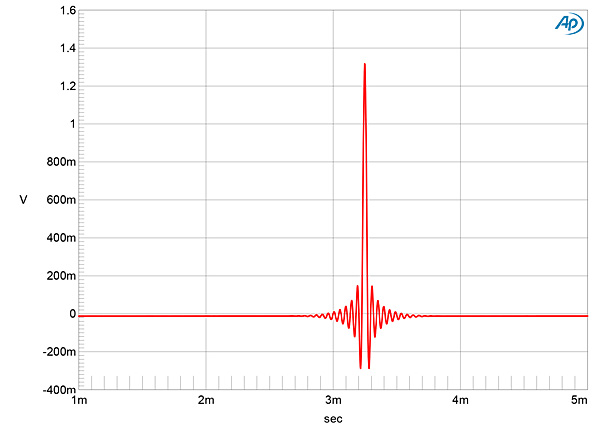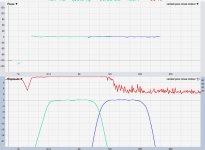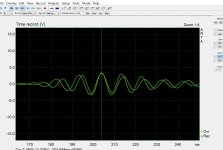^Good. (..gold star time!)
Better = Youtube Video showing the process.
Thanks Scott !
The technique is so easy a Youtube isn't even needed.
Using Arta in dual channel, go to Imp mode.
Under 'Record', open drop down option 'Signal time record'
Select Sine Burst button, and use settings as in screen shot above in #16.
Hit Generate, then Record.
A single wavelet will be recorded....Zoom and scroll for a good look.
Set as Overlay when you like the wavelet's size/position.
And then repeat Generate & Record for next driver/section, for comparison to overlay. (after using same zoom/scroll as per first wavelet capture)
That's it 😀
I guess that what you are seeing is caused by the sidebands present during amplitude modulation of a sinewave.
If a wavelet consists of three (sinewave) frequencies, filter two of them and you are left with the third.
Thanks Mark, i figure it's something like that, or something else entirely new to me.
Gotta go look up amplitude modulation. Always more to learn, huh? 🙂
When you look at this wave form distortion there are two things to consider, phase delay and group delay. The start and end points of the wavelet are delayed by the group delay. The distortion of the wave form is due to phase delay. Let's call group delay, Gd, and phase delay, Pd, phase, phi, and frequency, w.
Gd = -d(phi)/dw. That is Gd negative the slope of the phase vs frequency.
Pd = - phi/w.
If a system is linear phase vs w, then Gd = Pd.
Thanks Rob!
Hi John, thanks for the in depth reply.
My apologies for not having explicitly stated the LR4 and LR16 xovers were linear phase. I figure almost everybody knows linear phase is all i will use without extreme coercion. Lol.
(for the very reason to avoid all the complications you kindly showed !)
The delay time for the two boxes without any xover in place was 0.3ms, which accurately reflected time-of-flight to mic distances.
With the linear phase LR4 in place, delay moved to 0.46ms.
With the LR16, it moved to 0.8ms.
Those delay times were derived from aligning the central peaks of the wavelets.
The 0.5ms variation in delay, from no xover to LR16, is surely minuscule compared to the group delays your examples provided, but I really expected there would be zero variation.
I think that 0.5ms variation may be from a few possibilities.
First, only linear phase xover were used. There were no out-of-band minimum phase EQs applied to make sure acoustic response equaled true electrical LR rolloffs.
Second, the particular processing setup I was using has a 4k tap per channel capability, and i know from long experience that can almost hold a true LR12 shape at 100Hz. My bad there.
Last, the 'sub' is a vented box, the 'mid' is sealed. Both use the same 18" driver. I figure the high end roll-off of the sub is 2nd order, and the low end of the mid is the same. But I'm less secure in my knowledge of such things.
Anyway, the wavelets show such fine repeatability, i want to dig deeper into how they can be used.
The most puzzling thing so far, is how very different the tone of the same sine burst sounds on either side of the same xover. Can't wait to learn what that's about.
In the prosoundsweb article it states that the wavelet will have a broader spectrum than the pure sine signal. I don't understand why that would be but if one just accepts that then does it not stand to reason the hp and lp versions would sound different?
Yes !
Thanks for that Kevmoso, made me read the article again.
I don't understand why a wavet has a broader spectrum either, but it sure ties with what I've been hearing.
Just now, i tried listening to the wavelet played through both the sub and mid, where the only variable is the order of the lin phase LR xovers.
Interestingly, the sound is a little deeper and stronger the steeper the xover.
Recorded wavelets show a little more amplitude too. Must find out why.
I'm going to stop and get my better processor in play, to make sure I'm not getting any LR matching slippage from the FIR xover due to lack of taps.
And also switch to using two sealed 18"s, instead of one vented, one sealed.
Want to eliminate variables. Never seen this kinda precision low-end measurement environment before
Thanks for that Kevmoso, made me read the article again.
I don't understand why a wavet has a broader spectrum either, but it sure ties with what I've been hearing.
Just now, i tried listening to the wavelet played through both the sub and mid, where the only variable is the order of the lin phase LR xovers.
Interestingly, the sound is a little deeper and stronger the steeper the xover.
Recorded wavelets show a little more amplitude too. Must find out why.
I'm going to stop and get my better processor in play, to make sure I'm not getting any LR matching slippage from the FIR xover due to lack of taps.
And also switch to using two sealed 18"s, instead of one vented, one sealed.
Want to eliminate variables. Never seen this kinda precision low-end measurement environment before
I remember Linkwitz using this type of signal and due to that Eric Wallin added the feature to SpeakerWorkshop way back in the day. I played a bit with it then but don't remember much about it.
Searching the Linkwitz site may provide some insight.
Searching the Linkwitz site may provide some insight.
I don't understand why a wavet has a broader spectrum either, but it sure ties with what I've been hearing.
In the first post of this thread (which you made) you provided a link to a web page called "Signal Aligning Using Wavelets" and in that article there is a plot of the frequency spectrum of a 5-cycle wavelet. This plot:

There is more than a single frequency contained in the wavelength - it's similar to a bandpass. The wavelength is compact in both time and frequency, but is neither infinitely short, nor a single frequency.
I believe SL used these kinds of stimuli to probe energy storage. See:
Test signal
Issues in speaker design - 2
Yep. thx Charlie, I can be kinda dense sometimes...about taking it all in and connecting the obvious dots.
I remember Linkwitz using this type of signal and due to that Eric Wallin added the feature to SpeakerWorkshop way back in the day. I played a bit with it then but don't remember much about it.
Searching the Linkwitz site may provide some insight.
Correction: Mark Zachmann made SpeakerWorkshop and added the feature.
Thanks Rob!
Hi John, thanks for the in depth reply.
My apologies for not having explicitly stated the LR4 and LR16 xovers were linear phase. I figure almost everybody knows linear phase is all i will use without extreme coercion. Lol.
(for the very reason to avoid all the complications you kindly showed !)
The delay time for the two boxes without any xover in place was 0.3ms, which accurately reflected time-of-flight to mic distances.
With the linear phase LR4 in place, delay moved to 0.46ms.
With the LR16, it moved to 0.8ms.
Those delay times were derived from aligning the central peaks of the wavelets.
The 0.5ms variation in delay, from no xover to LR16, is surely minuscule compared to the group delays your examples provided, but I really expected there would be zero variation.
I think that 0.5ms variation may be from a few possibilities.
First, only linear phase xover were used. There were no out-of-band minimum phase EQs applied to make sure acoustic response equaled true electrical LR rolloffs.
Second, the particular processing setup I was using has a 4k tap per channel capability, and i know from long experience that can almost hold a true LR12 shape at 100Hz. My bad there.
Last, the 'sub' is a vented box, the 'mid' is sealed. Both use the same 18" driver. I figure the high end roll-off of the sub is 2nd order, and the low end of the mid is the same. But I'm less secure in my knowledge of such things.
Anyway, the wavelets show such fine repeatability, i want to dig deeper into how they can be used.
The most puzzling thing so far, is how very different the tone of the same sine burst sounds on either side of the same xover. Can't wait to learn what that's about.
As you mentioned, could be the FIR processing. Remember FIR filters have preringing and HP and LP will be different, and will be different with order.

As you mentioned, could be the FIR processing. Remember FIR filters have preringing and HP and LP will be different, and will be different with order.
I can't see how; and feel 99% certain preringing is not the cause of what I'm hearing and measuring.
The sound/measurement curiosity has been a distinct tonal difference from the wavelet generated at xover frequency, on the two sides of the xover.
Which i feel is well explained with a wavelet burst having a broader spectrum than a simple sine wave of the same frequency.
Do you think there is more to it?
Simple bottom line for me.... the tonal difference is waaay too big to be due to any audibly real, or not, preringing.
I'm going to stop and get my better processor in play, to make sure I'm not getting any LR matching slippage from the FIR xover due to lack of taps.
And also switch to using two sealed 18"s, instead of one vented, one sealed.
Want to eliminate variables. Never seen this kinda precision low-end measurement environment before
Quoting myself to show where i left off....
Soon realized i was making things too hard.
Said to self, "Why am i using two different subs?
You idiot......Just use the same sub to measure & listen to both sides of xover !" They go plenty high to do so. duh Lol
So onto the processor. Turns out there was the suspected FIR slippage from using 4k taps for 100Hz xover and 96 dB/oct.
Switched to 16k taps, and as can been seen below, problem solved....
fully complementarity at xover now.
Vented 18", 30Hz BW4 hp and 100Hz LR16 lp ; green traces
Sealed 18" (used as low-mid), 100Hz LR16 hp and 300Hz LR lp, blue traces.
Measurements/tunings made indoors at about a foot from dust cap.

After getting those variables out of the way, I've made many recordings of the bursts. Come to prefer 5-cycle triangle shaped. Gauss shaped is as easy to identify as a triangle burst up close, but further away triangle seems clearer to read central peak.
The time repeatability of the central peaks continues to blow me away. Literally to the sample.
It's also cool to play with all-pass filters to level the peaks on each side of the central peak.
As flat as the above phase traces are, the wavelets still show a little tilt from the upper and lower ends of the bandwidths.
I think the wavelets are an ultra-fine tuning mechanism for phase, much as square waves are for the totality of mag and phase.
Here's wavelets of the lower and upper sub as processed, timed together at 100Hz.
Tan is 30-100Hz, Green 100-300Hz.

isnt the aligning of phase going to be a compromise, since moving the mic to another position will give different results?
Sure, of course. Just like moving the mic will also give different frequency results.
You might call aligning phase a compromise, but seems to me the same logic would have to apply to frequency response.
I see the fundamental compromise as simply being multiple sources;
with the inescapable decisions on how to best tie their responses together.
You might call aligning phase a compromise, but seems to me the same logic would have to apply to frequency response.
I see the fundamental compromise as simply being multiple sources;
with the inescapable decisions on how to best tie their responses together.
As you mentioned, could be the FIR processing. Remember FIR filters have preringing and HP and LP will be different, and will be different with order.
Sorry John, my previous reply didn't fully take in what maybe you were pointing me to. I'm hoping so..
I saw 'preringing' and shortsightedly said, oh please not more preringing fault finding.
But I get if HP and LP aren't truly complementary, which they weren't because of prior limited tap count...well, then yes, there can be preringing.
Again, hoping that is what you pointing me to.
Happily all is well with truly complementary.
mark do you remember this from three years ago deja vu?
More thoughts (and pictures) on crossovers, phase, and delay
More thoughts (and pictures) on crossovers, phase, and delay
What do you think? To me it looks like you are aligning one output at approximately 92 and the other at 108 Hz.
Last edited:
mark do you remember this from three years ago deja vu?
More thoughts (and pictures) on crossovers, phase, and delay
No, i didn't remember it at all !!!
Thank you, and that past conversation makes much more sense now 🙂
What do you think? To me it looks like you are aligning one output at approximately 92 and the other at 108 Hz.
I think the wavelets have a broader frequency spectrum than a sine wave, like Kevmoso mentioned and Charlie posted a picture of in #27.
I think that makes it look like one output is at around 92 and the other 108Hz, but that the sound and measurements reflect the spectrum's distribution that make it through the high pass and low pass.
IOW same spectrum, but with different weighted outputs.
Tis the thinking so far at least 🙂
After filtering, you get a new wavelet centred around a new frequency and a new spectrum.
Let's say your 100Hz wavelet has a frequency range of 80Hz to 120Hz. After the lowpass filter, the shape of the spectrum changes with a sloped reduction from approximately 90Hz to 120Hz, placing the new centre (peak) at 92Hz. So, to me, it looks like you are aligning 92Hz and 108Hz.
Let's say your 100Hz wavelet has a frequency range of 80Hz to 120Hz. After the lowpass filter, the shape of the spectrum changes with a sloped reduction from approximately 90Hz to 120Hz, placing the new centre (peak) at 92Hz. So, to me, it looks like you are aligning 92Hz and 108Hz.
- Home
- Loudspeakers
- Multi-Way
- Neat way to find delay, phase, and polarity at xover